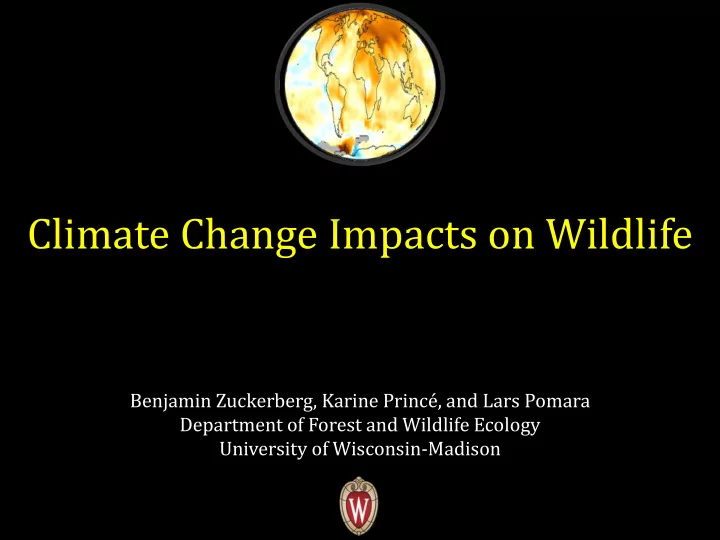

Climate Change Impacts on Wildlife Benjamin Zuckerberg, Karine Princé, and Lars Pomara Department of Forest and Wildlife Ecology University of Wisconsin-Madison
Acknowledgements Brad Potter Upper Midwest and Great Lakes LCC Karl Martin Wisconsin DNR Olivia LeDee, Mike Larson Minnesota DNR Chris Hoving Michigan DNR John Tirpak Gulf Coastal Plains and Ozarks LCC Megan Skrip University of Rhode Island Dave Lorenz, Mike Notaro, Brooke Bateman UW-Madison David Bonter, Wes Hochachka Cornell Jeremy Ash, Jesse Koyen, Win Sim Tan Research assistants Zuckerberg Climate Change Ecology Lab
Anthropogenic Climate Change Rising temperatures Shifting precipitation Attenuating winters Onset of spring Extreme weather Ocean acidification
Ecological response Distributions: Phenology: Shifts in space Shifts in time Dynamics: Biotic interactions: Shifts in demography Shifts in communities
Ecological response Distributions: Phenology: Shifts in space Shifts in time Dynamics: Biotic interactions: Shifts in demography Shifts in communities
Poleward Shifts
Poleward Shifts Relationship between observed and expected range shifts in response to climate change Northward shift of 16.9 km per decade Chen et al . 2011 Science
Poleward Shifts More than half of observed animal range boundaries have already shown a response to anthropogenic warming
Sentinels of Climate Change Shifting ranges of individual species result in a re-shuffling of communities
Southeast Region Northern Mourning Dove Tufted Titmouse Carolina Wren Cardinal Red-bellied American Downy Blue Jay Woodpecker Goldfinch Woodpecker
Mid-Atlantic Region Black-capped Northern Tufted Mourning Dove Chickadee Cardinal Titmouse Northern Mourning Dove Tufted Titmouse Carolina Wren Cardinal Dark-eyed Downy Red-bellied House Finch Junco Woodpecker Woodpecker Red-bellied American Downy Blue Jay Woodpecker Goldfinch Woodpecker
Great Lake Region American Black-capped Dark-eyed American Tree Goldfinch Chickadee Junco Sparrow Northern White-breasted Blue Jay Mourning Dove Cardinal Nuthatch Black-capped Northern Tufted Mourning Dove Chickadee Cardinal Titmouse Northern Mourning Dove Tufted Titmouse Carolina Wren Cardinal Dark-eyed Downy Red-bellied House Finch Junco Woodpecker Woodpecker Red-bellied American Downy Blue Jay Woodpecker Goldfinch Woodpecker
Species Thermal Index (STI ) measures the long-term temperature experienced by individual species over its range STI = - 6.77 -4.45
Community Thermal Index (CTI) reflects, for a species assemblage, the balance between cold - and warm -temperature dwelling species 𝑜 𝑏 𝑗,𝑘 × 𝑇𝑈𝐽 𝑗 𝑜 𝑇𝑈𝐽 𝑗 𝑗=1 𝑗=1 CTI 𝑘 = CTI 𝑘 = 𝑜 𝑜 𝑏 𝑗,𝑘 𝑗=1 Unweighted CTI Weighted CTI Devictor V et al. (2008) Birds are tracking climate warming, but not fast enough. Proceedings of the Royal Society B-Biological Sciences, 275 , 2743-2748.
Community Thermal Index (CTI) CTI T 0 T 1
-4.0 Community Thermal Index 2.2 ± 0.1 x 10 -3 °C yr -1 Warm-adapted birds increasing in their dominance -4.4 1990 2000 2012
0.7 × 10 -3 Community Thermal Index 2.5 × 10 -3 4.1 × 10 -3 5.3 × 10 -3 1990 2012
Which species are driving CTI trends? Jackknife analysis: species’ contribution ( C sp ) Community Thermal Index 2.7 x 10 -3 C sp 1.6 x 10 -3 1990 2000 2012
Which species are driving CTI trends? Smaller-bodied Southerly Increasing C sp Body mass (log-scale) Northern range boundary Trend in occupancy
Wildlife response Distributions: Phenology: Shifts in space Shifts in time Dynamics: Biotic interactions: Shifts in demography Shifts in communities
Climate Change Vulnerability Assessment Sensitivity Exposure Populations respond to Conditions vary over environmental change time and space Demographic niche modeling Vulnerability Conservation efforts
Climate change and population cycling Relative abundance Stronger cycling Weaker cycling Ruffed Grouse Bonasa umbellus
Sensitivity Ruffed Grouse Bonasa umbellus Adult and juvenile survival and nest success, 1963-2009 Studies 17 Site-year combinations 51 Ron Austing Individual-years, telemetered birds 2490 Monitored nests 498
Sensitivity Winter Climate Anomalies Cold Warm High snow Rain Year 2000 Precip in driest month High expected survival Cold Warm Low expected survival Diana McElroy Low snow Low snow
Sensitivity Nonbreeding survival Min temp * Min precip Deviance explained: 89% Predicted survival, 2000 Diana McElroy
Sensitivity Nest success Max temp + Max precip Deviance explained: 68% Predicted nest success, 2000
Exposure Spatially explicit demographic models
Exposure Spatially explicit demographic models N per cell , 1999 2000 2001 Life cycle m Nest success ρ Breeding season survival ϕ Nonbreeding survival
Ruffed Grouse spring drumming survey >300 survey routes Minnesota DNR 1982 - 2013 Michigan DNR 1990 - 2013 Wisconsin DNR 1994 - 2013
Model Evaluation 1982 - 2013 N per cell, 2000 Mean drums / route Model prediction: mean N / cell
Future forecasts 1982 - 2080 CMIP5, rcp8.5 N per cell, 2060 Mean drums / route Model prediction: N / cell
Ecological Impacts of Climate Change Poleward shifts Reshuffling of species Sensitivity Climate influences vital rates Exposure Variation in climate variability Population dynamics Cycling and extinction risk
Recommend
More recommend